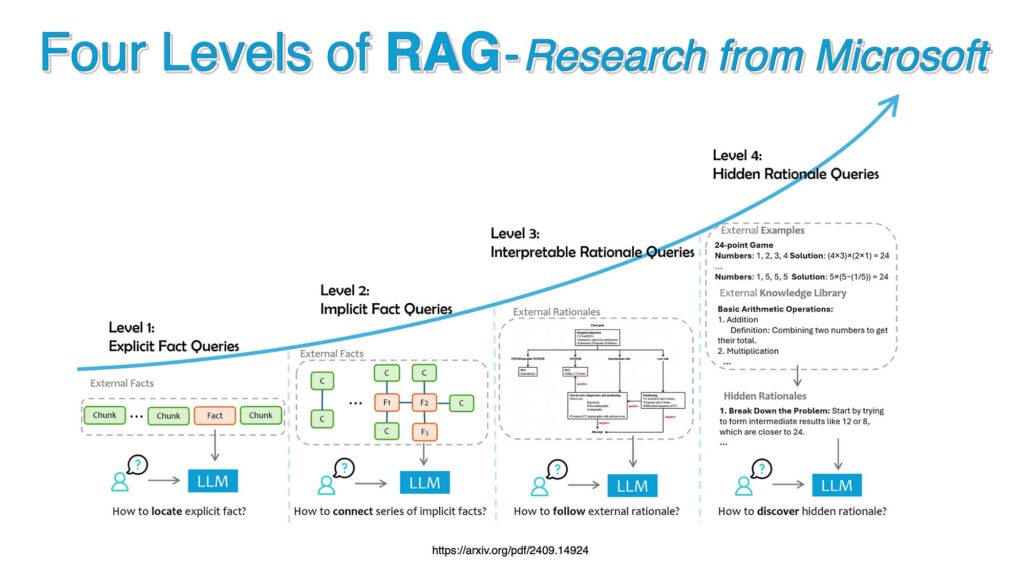Let’s delve into the concept of Retrieval-Augmented Generation (RAG), a cutting-edge methodology that enhances data processing by combining retrieval techniques with the capabilities of large language models (LLMs). RAG is at the forefront of AI innovation, enabling systems to retrieve relevant information efficiently and generate coherent responses, thereby advancing complex reasoning tasks. However, implementing accurate RAG systems presents challenges such as effective data retrieval, understanding user intent, and leveraging LLMs to their fullest potential. This playbook section explores these challenges and provides a structured approach to understanding RAG through four levels of query complexity.
RAG represents a significant shift in AI-driven data processing. By augmenting traditional retrieval methods with generative models, RAG enables more dynamic and contextually aware interactions. The significance of RAG lies in its ability to not only find specific pieces of information but also to generate insightful, context-rich responses. Despite its promise, building effective RAG systems is not without hurdles. Data retrieval can be hampered by incomplete or ambiguous queries, while user intent interpretation requires sophisticated understanding to ensure relevant results. Moreover, utilizing LLMs for complex reasoning necessitates precise tuning and integration with external data sources to enhance response accuracy.
Implementing RAG systems involves navigating several challenges. One of the primary issues is ensuring accurate data retrieval, which depends on well-structured databases and efficient search algorithms. User intent interpretation is another critical component, requiring advanced natural language processing to discern the true nature of user queries. Furthermore, leveraging LLMs for complex reasoning demands careful alignment with domain-specific knowledge and guidelines. In this context, the following sections introduce a framework for understanding different levels of RAG query complexity, from explicit fact queries to hidden rationale queries, illustrating the increasing sophistication required for each level.

Level 1: Explicit Fact Queries #
Explicit fact queries are simple and direct. They involve straightforward requests for specific, known facts within a dataset. These queries are typically easy to handle because they require minimal interpretation beyond locating and extracting the relevant information.
– Characteristics: Direct requests for specific facts.
– Simplicity: Focus on retrieving known information with minimal processing.
– Example: “What is the capital of France?”
Understanding explicit fact queries lays the groundwork for exploring more complex types of queries, such as implicit fact queries.
Level 2: Implicit Fact Queries #
Implicit fact queries demand more than straightforward fact retrieval. These queries require interpretation and common sense reasoning to uncover answers that may not be directly stated in the data. Inferencing and synthesis from multiple data segments become crucial.
– Characteristics: Queries needing interpretation beyond direct data retrieval.
– Reasoning: Requires inferencing and synthesis of information from various sources.
– Example: Determining an employee’s likely job satisfaction based on indirect metrics like productivity and engagement.
These implicit fact queries pave the way for understanding interpretable rationale queries, where reasoning is crucial.
Level 3: Interpretable Rationale Queries #
Interpretable rationale queries focus on understanding the reasoning behind facts. Such queries often require applying domain-specific guidelines and integrating external resources for insights not covered during initial model training.
– Characteristics: Queries requiring an understanding of reasoning and application of domain-specific guidelines.
– External Resources: Dependence on additional data for comprehensive rationales.
– Example: In financial auditing, explaining discrepancies between reported and actual figures using established protocols.
Once the reasoning behind facts is understood, the next level involves uncovering deeper insights through hidden rationale queries.
Level 4: Hidden Rationale Queries #
Hidden rationale queries require advanced context-based reasoning to derive deeper insights and implications. These queries challenge AI systems to infer complex rationales from patterns and outcomes within the data.
– Characteristics: Context-based reasoning for deeper insights.
– Complexity: Inferring rationales from subtle patterns and outcomes.
– Example: In IT operations, analyzing system logs to predict future failures based on past anomalies.
The exploration of these four query levels underscores the increasing complexity and sophistication required in RAG systems.
In conclusion, understanding the four levels of RAG highlights the spectrum of complexity in data interpretation and decision-making. From explicit fact queries to hidden rationale queries, each level demands progressively more sophisticated processing and reasoning capabilities. As advancements in LLMs continue, the potential to enhance RAG capabilities across various domains grows, promising more nuanced and effective AI-driven solutions for the future.
